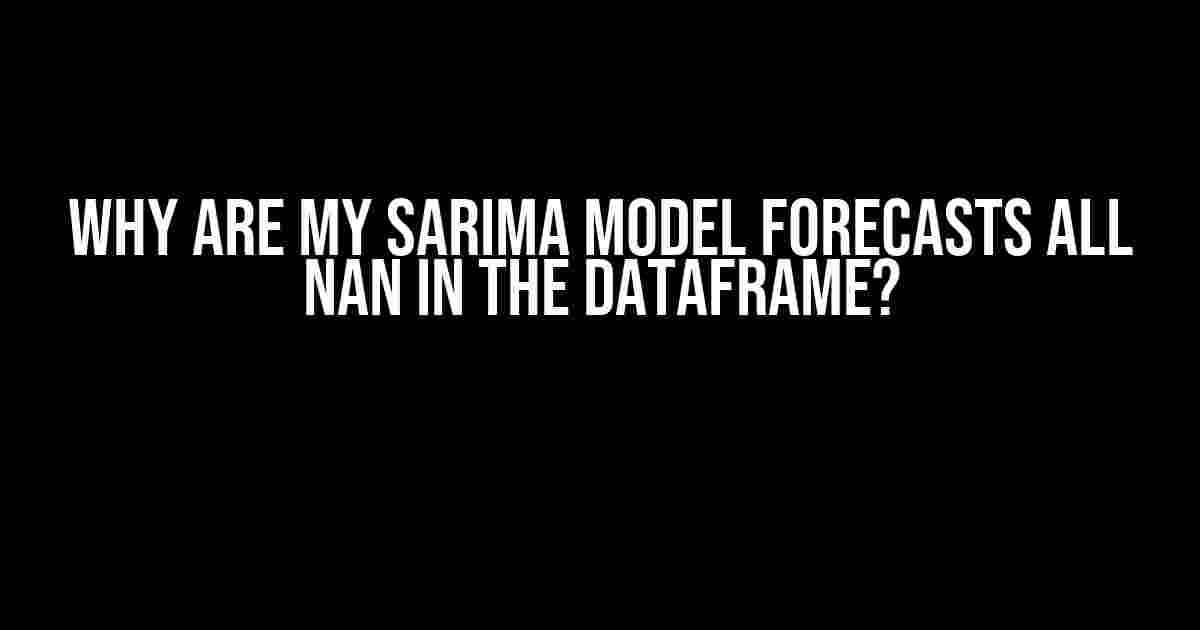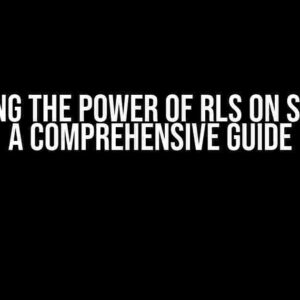Are you tired of staring at a DataFrame filled with NaN values, wondering why your SARIMA model forecasts refuse to materialize? You’re not alone! In this article, we’ll delve into the most common reasons behind this frustrating issue and provide step-by-step solutions to get your forecasts up and running.
Reason 1: Data Quality Issues
Data quality is crucial for building an accurate SARIMA model. If your dataset contains missing, duplicate, or erroneous values, it can lead to NaN forecasts. Let’s tackle these issues one by one:
Missing Values
Check for missing values in your dataset using the isnull().sum() method:
import pandas as pd
# Load your dataset
df = pd.read_csv('your_data.csv')
# Check for missing values
print(df.isnull().sum())If you find any missing values, consider imputation techniques like mean, median, or interpolation to fill the gaps. For example, to fill missing values with the mean:
df.fillna(df.mean(), inplace=True)Duplicate Values
Duplicates can also cause NaN forecasts. Identify duplicates using the duplicated() method:
print(df.duplicated().sum())Remove duplicates by keeping only the first occurrence:
df.drop_duplicates(inplace=True)Erroneous Values
Inspect your dataset for outliers or erroneous values that might be affecting your model. You can use statistical methods like the Z-score or visualize your data using plots to identify anomalies:
import matplotlib.pyplot as plt
# Plot your data
plt.plot(df)
# Visualize outliers
plt.boxplot(df)Handle outliers by either removing them or transforming your data using techniques like log scaling or normalization.
Reason 2: Model Configuration Issues
Sometimes, the problem lies in the way you’ve configured your SARIMA model. Let’s explore common mistakes:
Model Order
A incorrectly specified model order can lead to NaN forecasts. Ensure you’ve selected the appropriate order (p, d, q) using techniques like:
- Autocorrelation Function (ACF) and Partial Autocorrelation Function (PACF) plots
- Information Criteria (AIC, BIC)
- Cross-validation
For example, use the autoarima library to automatically determine the optimal model order:
from autoarima import AutoARIMA
model = AutoARIMA(df, seasonal=True)
model_fit = model.fit()
print(model_fit.order)Seasonality
Failing to account for seasonality can result in NaN forecasts. Make sure to specify the correct seasonal period and include it in your model configuration:
from statsmodels.tsa.statespace.sarimax import SARIMAX
model = SARIMAX(df, order=(1,1,1), seasonal_order=(1,1,1,12))
model_fit = model.fit()
forecast = model_fit.forecast(steps=30)Reason 3: Implementation Issues
Even with a correct model configuration, implementation mistakes can still lead to NaN forecasts. Let’s troubleshoot common errors:
Data Preprocessing
Ensure you’ve properly preprocessed your data before feeding it into the SARIMA model. This includes:
- Converting date columns to datetime format
- Setting the index to the date column
- Resampling data to a consistent frequency
import pandas as pd
# Convert date column to datetime
df['date'] = pd.to_datetime(df['date'])
# Set index to date column
df.set_index('date', inplace=True)
# Resample data to monthly frequency
df = df.resample('M').mean()Model Fitting
Verify that you’ve correctly fitted the SARIMA model to your data:
model_fit = model.fit(maxiter=500, method="powell")In this example, we’re using the Powell optimization method with a maximum of 500 iterations.
Forecasting
Double-check your forecasting code to ensure it’s correct:
forecast = model_fit.forecast(steps=30)In this example, we’re forecasting 30 time steps ahead.
Reason 4: Model Limitations
SARIMA models have limitations that can cause NaN forecasts. Be aware of these constraints:
Non-Stationarity
SARIMA models assume stationarity in the data. If your data is non-stationary, consider using techniques like differencing or detrending to make it stationary.
Multivariate Data
SARIMA models are designed for univariate time series. If you’re working with multivariate data, consider using alternative models like Vector Autoregression (VAR) or Multivariate SARIMA.
Conclusion
By systematically addressing data quality issues, model configuration mistakes, implementation errors, and model limitations, you should be able to resolve the NaN forecast problem in your SARIMA model.
Remember to:
- Inspect your dataset for missing, duplicate, or erroneous values
- Choose the correct model order and account for seasonality
- Properly preprocess your data and implement the SARIMA model correctly
- Be aware of model limitations and consider alternative approaches when necessary
With these guidelines, you’ll be well on your way to generating accurate forecasts with your SARIMA model.
| Reason | Solution |
|---|---|
| Data Quality Issues | Handle missing values, remove duplicates, and address erroneous values |
| Model Configuration Issues | Choose the correct model order, account for seasonality, and configure correctly |
| Implementation Issues | Properly preprocess data, fit the model correctly, and forecast accurately |
| Model Limitations | Aware of model constraints, consider alternative approaches when necessary |
Now, go ahead and solve that NaN forecast problem! 📈
Frequently Asked Question
Frustrated with SARIMA model forecasts filled with NaN? We’ve got the answers!
Why are my SARIMA model forecasts all NaN in the DataFrame if I’ve followed the correct implementation?
A common gotcha! Check if your SARIMA model is being fitted to the entire dataset, including the forecast period. Make sure to split your data into training and testing sets, and only fit the model to the training data. Then, use the testing data to generate forecasts. This should fix the NaN issue!
Can I get NaN forecasts if my data has missing values?
Yes, you can! If your data contains missing values, it’s likely that your SARIMA model will produce NaN forecasts. Try filling the missing values using suitable methods like interpolation, mean/median imputation, or even using a separate model to predict the missing values. Clean data = better forecasts!
Are there any issues with my DataFrame that could cause NaN forecasts?
Absolutely! If your DataFrame has DateTimeIndex issues, such as non-unique dates or incorrect frequency, it can lead to NaN forecasts. Ensure your index is clean and set the frequency correctly. You can also try resetting the index or re-creating the DateTimeIndex from scratch. Give it a try!
Can incorrect model parameters cause NaN forecasts?
You bet! If your SARIMA model’s parameters (p, d, q) are not well-suited for your data, you might end up with NaN forecasts. Try using autoarima or other methods to select the optimal parameters. You can also experiment with different parameters to see what works best for your data. Experimentation is key!
Are there any library or version issues that could cause NaN forecasts?
Unfortunately, yes! Sometimes, library or version issues can cause NaN forecasts. Ensure you’re using the latest versions of libraries like statsmodels, pandas, and numpy. If you’re using an older version, try updating to the latest version. If the issue persists, try using a different library or searching for known issues related to your versions.



